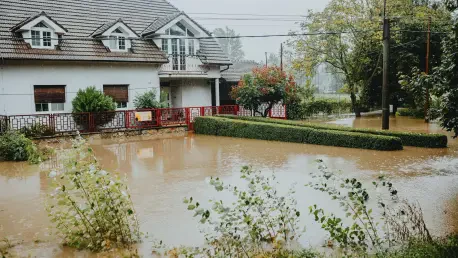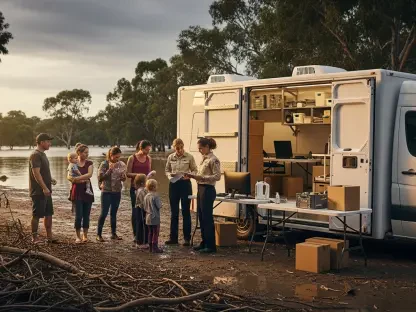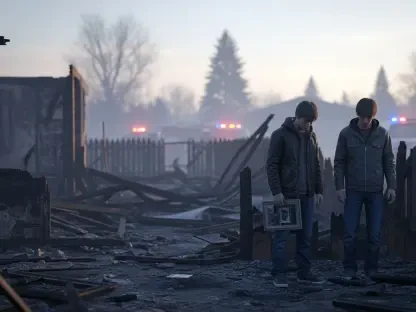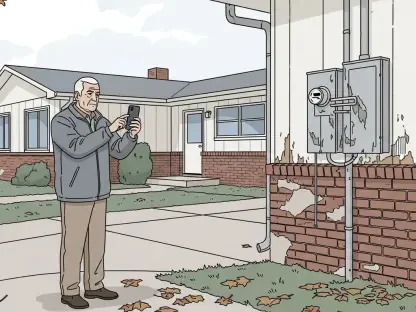In the United States, the dream of homeownership is increasingly overshadowed by a harsh reality: the skyrocketing cost of home insurance driven by the relentless impacts of a warming planet, a crisis that is fundamentally altering the financial landscape for millions. Climate change is no longer a distant concern but a tangible force that’s intensifying natural disasters and affecting homeowners across the nation. From coastal communities battered by ferocious hurricanes to inland areas struck by unprecedented storms, the consequences are reverberating through individual households, entire neighborhoods, and the broader housing market. This crisis is unfolding in stark clarity in places like Sanibel Island, Florida, once a paradise for insurers with low claims and high premiums, now a symbol of devastation after Hurricane Ian tore through in 2022. Homeowners there, and across the country, are grappling with losses that go beyond the physical, hitting their wallets and sense of security. The question looms large—how did this situation spiral to such a critical point, and what does it mean for the future of living in vulnerable regions? Delving into the intersection of environmental shifts, industry failures, and personal struggles reveals a complex web that threatens the very foundation of homeownership for many.
A Warming Planet Intensifies Natural Disasters
The undeniable reality of climate change is manifesting in more frequent and destructive natural disasters across the country. Hurricanes such as Ian, Helene, and Milton have unleashed havoc on Florida, while raging wildfires continue to devastate California, and severe storms batter the Midwest with alarming regularity. Rising sea levels are encroaching on coastal properties, and heavier rainfall is triggering floods in areas previously deemed safe. These aren’t isolated incidents but part of a broader pattern tied to a warming planet, where extreme weather events are becoming the norm rather than the exception. The financial toll is staggering, with damages running into billions annually, leaving homeowners to confront not just the physical destruction of their properties but the erosion of their economic stability. This surge in catastrophic events is redefining risk in ways that few could have anticipated even a decade ago, setting the stage for a profound crisis in how homes are protected.
Beyond the immediate destruction, the long-term implications of these climate-fueled disasters are reshaping entire regions. Properties once considered low-risk are now in the crosshairs of floods, windstorms, and even hail, as weather patterns grow increasingly erratic. Homeowners in these areas find themselves facing threats they never planned for, with insurance policies that once offered peace of mind now proving inadequate against the scale of modern disasters. The broader impact extends to community planning and infrastructure, as local governments struggle to adapt to a reality where rebuilding after each event becomes more costly and less sustainable. This evolving landscape of risk is not just a challenge for individuals but a systemic issue that demands urgent attention, as the very notion of a safe place to live is called into question by the relentless advance of climate change.
Insurance Sector Struggles with Unprecedented Losses
The insurance industry, long reliant on historical climate models to predict risk, is now buckling under the weight of a rapidly changing environment. Companies are paying out billions in claims for damages from events like Hurricane Ian, which alone resulted in $620 million in flood claims on Sanibel Island through federal programs. Across the nation, property insurers are grappling with staggering losses from wind, fire, and other damages, with recent disasters ranking among the costliest in recorded history. These financial hits have exposed the fragility of an industry built on outdated assumptions about weather patterns, leaving many insurers unable to sustain operations in high-risk areas. As a result, major players are withdrawing from states like Florida, California, and Texas, while smaller companies face insolvency, creating a void that leaves countless homeowners without a safety net.
This retreat from vulnerable markets has led to widespread policy cancellations, amplifying the crisis for those who need coverage most. Homeowners in affected regions are finding their policies non-renewed or dropped altogether, often with little warning or alternative options. The industry’s inability to adapt quickly to the new reality of climate-driven risks means that even those who manage to retain coverage face terms that are far less favorable than before. Meanwhile, the ripple effects are felt in state-backed insurance programs, which are increasingly strained as they attempt to fill the gaps left by private insurers. This systemic upheaval signals a profound shift in how risk is managed, with the traditional model of home insurance teetering on the brink of collapse under the pressure of a warming world.
Premiums Soar as Coverage Becomes Elusive
For homeowners who can still secure insurance, the financial burden has become crushing. In Florida, average premiums are ballooning to four times the national average of around $2,300, while nationwide, rates have surged by 30 to 40 percent over the past five years. Stories of individuals like Deborah Brown from Fort Lauderdale, whose premiums doubled in a short span, highlight the stark choices many face—either absorb the exorbitant costs or abandon coverage entirely. This isn’t merely a matter of tighter budgets; it’s a direct threat to the ability to safeguard one’s most significant investment. As costs climb, the notion of insurance as a reliable protector against disaster is slipping away, leaving families exposed to potential ruin with each passing storm or wildfire.
The scarcity of affordable coverage compounds the problem, particularly in high-risk zones where insurers are increasingly unwilling to operate. Tens of thousands of homeowners have already canceled policies due to prohibitive costs, while others struggle to find any provider willing to take on their risk. This growing inaccessibility is creating a dangerous gap, where even those willing to pay find no options available. The disparity is especially acute for middle- and lower-income households, who lack the resources to self-insure or absorb losses out of pocket. As this trend accelerates, the divide between who can afford to protect their home and who cannot is widening, raising critical questions about equity and the future of homeownership in vulnerable areas.
Housing Markets Stumble Under Climate Risks
The fallout from the insurance crisis is reverberating through housing markets, particularly in regions prone to climate-driven disasters. Potential buyers are now weighing not just the price of a home but the hidden costs of soaring premiums and heightened risks, leading to hesitancy that stalls sales. In areas like Fort Myers and Cape Coral, an oversupply of unsold properties has emerged, with thousands of homes languishing on the market as real estate agents grapple with diminished demand. This slowdown isn’t a temporary blip but a reflection of a fundamental shift in how climate risk is reshaping buyer behavior, turning once-desirable locations into financial liabilities.
On Sanibel Island, the impact is even more pronounced, with median home prices dropping from $1.3 million during the COVID-era boom to $830,000 as buyers grow wary of future disasters and insurance challenges. This decline signals a broader trend where property values are directly tied to perceptions of climate vulnerability, altering the economic fabric of entire communities. Beyond individual transactions, the stagnation in these markets hints at long-term demographic changes, as families and investors alike reconsider the viability of living in areas where financial security is so closely linked to unpredictable natural events. The housing market, once a cornerstone of stability, is now a battleground where climate change dictates the terms.
Human Toll of an Uninsurable Reality
Behind the cold statistics of premiums and market trends are the personal stories of struggle and resilience that define this crisis. Consider Daniel Moore Thompson of Sanibel Island, who lost nearly everything in Hurricane Ian, salvaging only his Jeep and his dog from the wreckage. The prospect of rebuilding is daunting—elevating his home to mitigate future flood risks could cost between $100,000 and $200,000, a sum far beyond reach for many in similar situations. Yet, driven by deep-rooted ties to his community, Thompson remains committed to staying, embodying a determination to hold on despite the mounting odds. These individual battles reveal the emotional weight of a crisis that extends far beyond financial loss.
Contrast this with the experience of others like Deborah Brown, who faced premium hikes so severe that selling her Fort Lauderdale home became the only viable option. Forced to uproot her life, Brown represents countless homeowners who find themselves at a breaking point, unable to shoulder the escalating costs of protection. This dichotomy—between those who stay and risk everything and those who leave with heavy hearts—underscores a profound human dilemma. The personal toll of unaffordable insurance is reshaping not just balance sheets but the very sense of home, as families grapple with decisions that pit emotional attachment against economic survival in an era of unrelenting climate challenges.
Navigating Toward Sustainable Solutions
Looking back, the trajectory of this crisis revealed a sobering truth: climate change had been relentlessly driving up the frequency and severity of disasters, leaving the insurance industry scrambling to catch up. Premiums had soared, coverage had dwindled, and housing markets had faltered under the weight of newfound risks. Homeowners, from Sanibel Island to the Midwest, had faced impossible choices, their stories of loss and perseverance painting a vivid picture of a system in distress. The warnings from experts about an uninsurable future had grown louder, signaling that without intervention, entire regions could become economically untenable.
Moving forward, addressing this challenge demands innovative approaches and collective action. Policymakers could explore robust federal support mechanisms to bolster state insurance programs, ensuring they have the reserves to handle escalating claims. Incentivizing climate-resilient construction through subsidies for home elevation or fortified building standards might reduce future damages. Additionally, insurers must adapt by integrating real-time climate data into risk models, even if it means short-term losses for long-term stability. For homeowners, community-driven initiatives to pool resources for disaster preparedness could offer a buffer where traditional coverage fails. These steps, while complex, point to a path where the burden of a warming planet is shared, rather than borne by the most vulnerable alone.









